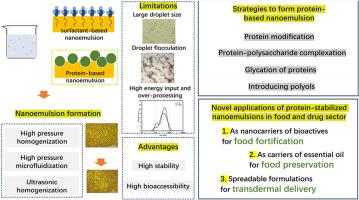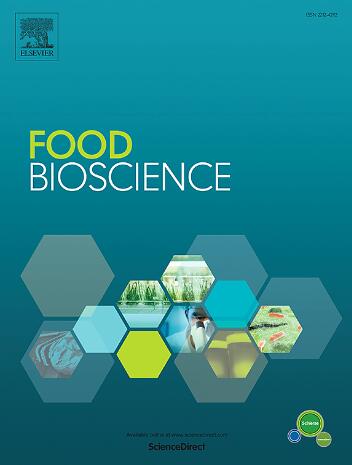食品蛋白基纳米乳:全面回顾,重点是促进形成和稳定的策略
IF 5.9
1区 农林科学
Q1 FOOD SCIENCE & TECHNOLOGY
引用次数: 0
摘要
纳米乳液含有微小的液滴(d < 200nm),使其具有比大乳液更好的特性,如更高的物理稳定性,高光学清晰度,以及亲脂成分的生物利用度增加,因此在各种食品,化妆品和制药领域具有广阔的应用前景。越来越多的证据表明,许多食品蛋白作为合成表面活性剂的替代品,在制造食品级纳米乳液方面具有巨大的潜力。然而,蛋白质在纳米乳液制备中的有效性尚未达成共识,主要是因为它们的乳化能力不如表面活性剂,容易导致大液滴尺寸,液滴絮凝,甚至在高能均质过程中“过度加工”。因此,提高蛋白质的乳化性能将是促进纳米乳形成和稳定的关键。本文综述了近年来蛋白质基纳米乳的形成和特性研究进展,重点介绍了蛋白质基纳米乳的优点和局限性。更多的重点放在促进蛋白质基纳米乳液形成和稳定的潜在策略上,包括蛋白质修饰、多糖络合、糖基化和多元醇的掺入,这些都有利于蛋白质配方纳米乳液在食品和药物领域的新应用。鉴于食品级纳米乳化剂的发展前景,本文综述对以蛋白质为天然乳化剂的食品级纳米乳化剂的开发和应用具有重要的指导意义。本文章由计算机程序翻译,如有差异,请以英文原文为准。

Food protein-based nanoemulsions: A comprehensive review with an emphasis on strategies to facilitate the formation and stabilization
Nanoemulsions contain tiny droplets (d < 200nm) that endow them with better characteristics than macroemulsions such as higher physical stability, high optical clarity, and increased bioavailability of lipophilic components, therefore imparting them with promising applications in a variety of food, cosmetics, and pharmaceutical fields. Accumulating evidence indicates the great potential of many food proteins for the fabrication of food-grade nanoemulsions as replacements for synthetic surfactants. However, the effectiveness of proteins in the fabrication of nanoemulsions has not reached a consensus mainly because of their inferior emulsifying capacity than surfactants that would readily lead to large droplet size, droplet flocculation, even “over-processing” during high energy homogenization. Therefore, improvement of protein emulsifying performance would be a key to facilitate the formation and stabilization of nanoemulsions. In this review, recent advances in the formation and characteristics of protein-based nanoemulsions are summarized with a focus on their advantages and limitations. More emphasis is given to potential strategies to facilitate the formation and stabilization of protein-based nanoemulsions, including protein modification, complexation with polysaccharides, glycation, and incorporation of polyols, which can be beneficial for novel applications of protein-formulated nanoemulsions in the food and drug sectors. As food-grade nanoemulsions are appealing, this review is of crucial importance for guiding the development and application of food-grade nanoemulsions using proteins as natural emulsifiers.
求助全文
通过发布文献求助,成功后即可免费获取论文全文。
去求助
来源期刊

Food Bioscience
Biochemistry, Genetics and Molecular Biology-Biochemistry
CiteScore
6.40
自引率
5.80%
发文量
671
审稿时长
27 days
期刊介绍:
Food Bioscience is a peer-reviewed journal that aims to provide a forum for recent developments in the field of bio-related food research. The journal focuses on both fundamental and applied research worldwide, with special attention to ethnic and cultural aspects of food bioresearch.
 求助内容:
求助内容: 应助结果提醒方式:
应助结果提醒方式:


